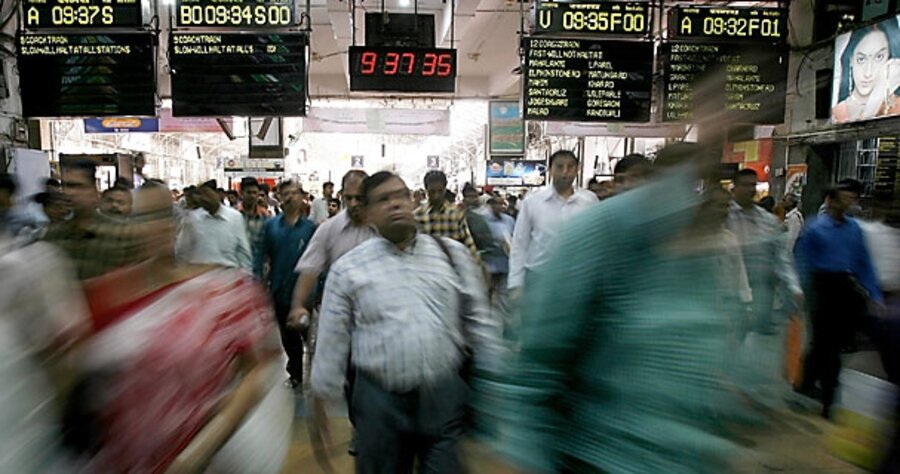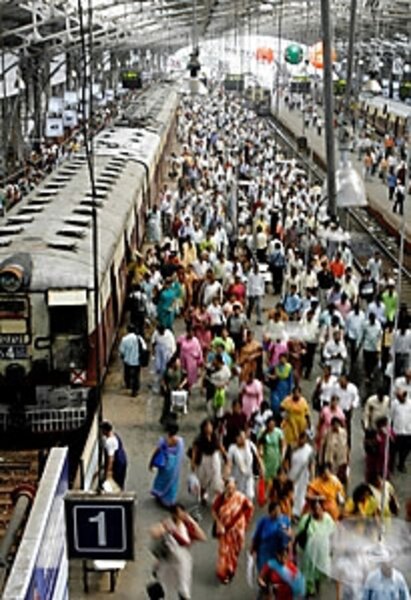Earth’s big problem: Too many people.
Loading...
Are there too many people on Earth?
That question is rarely raised today, in part because it conjures up the possibility of governments intruding into the most private and profound decision a couple can make. In a worst-case scenario, authorities could impose discriminatory policies that would limit births based on such criteria as race, ethnic origin, cultural background, religion, or gender.
But with huge, vexing questions such as food security, poverty, energy supplies, environmental degradation, and climate change facing humanity, some are asking whether aggressive measures to control population growth should be on the public agenda.
Politicians generally stay clear of suggesting population-control policies, recognizing the deep-seated concerns they raise. President Obama did not mention the issue as part of his campaign last fall. But the new Obama administration has promised to take a fresh look at solutions to energy and environmental challenges and has brought in a new slate of scientific advisers. The United States remains the only developed country without an official population policy.
Might the new administration dare to raise the idea?
“You’ve got to get a president who’s got the guts to say, ‘Patriotic Americans stop at two [children],’ ” says Paul Ehrlich, a professor of population studies at Stanford University. “That if you care about your children and grandchildren, we should have a smaller population in the future, not larger.” Professor Ehrlich wrote the groundbreaking 1968 book “The Population Bomb,” which predicted disastrous effects from unchecked population growth.
Earth’s population is about 6.8 billion people today, or four times the population of a century ago. Even though birth rates are lower than during the 1960s and ’70s, the world is adding 75 million to 80 million people per year and is expected to peak at more than 9 billion by midcentury – far too many, say some population experts.
Whether this growth can be sustained and still provide a decent living standard for people is itself controversial. Some, including Ehrlich and Alan Weisman, the author of the best-selling book “The World Without Us,” argue that even today’s population is too large to maintain without ravaging the environment and creating an inhospitable planet.
How much would today’s population have to shrink to become sustainable? “I don’t think anybody knows,” Mr. Weisman says. “All I know is, ‘less is better.’ ”
Weisman’s book imagines a world in which humans are extinct and suggests that nature could bounce back relatively quickly from the burden placed on it by its billions of human inhabitants.
Demographers calculate that if suddenly every family on earth limited itself to one child, by 2150 the world’s population would be 1.6 billion, exactly what it was at the beginning of the 20th century.
He’s not arguing that that’s a perfect number of humans. But “it would create a lot more space for [other] organisms to live ... a much healthier ecosystem for us all,” he says.
Lifestyles are bigger issue
Ehrlich and Weisman agree with critics who say population alone isn’t the issue. Lifestyles in developed countries in North America and Europe consume a lot of resources. Everyone living in an industrialized nation puts a much heavier burden on the environment than does someone living in, say, Asia or Africa. Though family sizes in the developed world are smaller, the number of households hasn’t shrunk commensurately.
“It’s actually the number of households – and not the number of people – that has a bigger impact on the environment,” says Matthew Connelly, a professor of history at Columbia University in New York and the author of “Fatal Misconception: The Struggle to Control World Population.”
“This is not a population crisis,” Professor Connelly argues. “The crisis is us, the consumption patterns of the wealthiest people in the world. That’s what’s unsustainable.” The problem in trying to control populations “is that we don’t know how to do it,” he says. “We don’t have a good theory to explain, much less predict, why people have babies and why they have as many as they do.”
China’s strict one-child-per-family policy, established 30 years ago, has cut its population growth significantly. But it has also created a huge gender imbalance, as families have chosen male children over female, he says.
“There’s a long history of governments trying to make it illegal for parents to have large families,” Connelly says. “China is just the most notorious example.” But, he asks, “Is that the kind of country we’d like to live in, where the government could make it illegal to choose the number of children we have?”
Doom-and-gloomers assume technology is static
Those arguing that a calamity awaits if population isn’t reduced are looking at the past and trying to project it into the future, says Ted Nordhaus, an environmentalist and coauthor with Michael Shellenberger of “Breakthrough: From the Death of Environmentalism to the Politics of Possibility.”
“They assume that technology and resources are static,” Mr. Nordhaus says, and that breakthroughs and discoveries that could dramatically improve living conditions on earth won’t be found.
“The greatest antidote to rapidly growing population is prosperity and development,” Nordhaus says. “As people become more prosperous, birth rates decline.... It’s an economic development challenge, not a population challenge.”
But that doesn’t mean that we need to just sit back and do nothing. “We can’t take a laissez-faire approach to this,” he says. “We can’t just assume technology advancement will happen as quickly as we would like it to. There are all kinds of things we need to do to invest in productivity improvement.”
Despite the fears of some, rising living standards in the developing world don’t mean that the environment will be devastated in the process, he says. The idea that Chinese and Indians will all be driving around in Humvees and flying in private jets is “not true,” he says.
The concept of some environmentalists that humans are somehow an intruder or “a scourge on the earth” disturbing an otherwise harmonious nature, needs to be challenged, Nordhaus says. “The reality is that nature is neither stable nor harmonious,” he says. “We’re as natural as anything else, and a world with us is as natural as a world without us.”
Short of government limits on family size, both advocates and opponents of population control agree that many other useful steps can be taken that may lead to reduced population growth. Among the most crucial are better education, economic opportunities, and access to contraceptive and reproductive health care services for women in developing countries with high birth rates.
As economist Robert Cassen put it in 1994, “Virtually everything that needs doing from a population point of view needs doing anyway.”
What effects will world population growth have by the mid-21st century? Joel Cohen, head of the Laboratory of Populations at Rockefeller University and Columbia University, makes the following points:
Emerging trends in Global population
• In 1950 the less-developed (poorer) regions of the world had roughly twice the population of the more developed (richer) ones. By 2050 the ratio will exceed 6 to 1.
• Human numbers currently increase by 75 million to 80 million people annually, the equivalent of adding another United States to the world about every four years.
• At present, the average woman bears nearly twice as many children (2.8) in poor countries as in rich countries (1.6 children per woman).
• Some 51 countries or areas will lose population between now and 2050. Germany is expected to drop from 83 million to 79 million people, Italy from 58 million to 51 million, Japan from 128 million to 112 million and the Russian Federation from 143 million to 112 million.
• If recent trends continue as projected to 2050, virtually all of the world’s population growth will be in urban areas.
• Everyone born in 1965 or earlier and still alive has seen human numbers more than double from 3.3 billion in 1965 to 6.8 billion in 2009.
• The peak population growth rate ever reached, about 2.1 percent a year, occurred between 1965 and 1970. Human population never grew with such speed before the 20th century and is likely never to grow with such speed again.






